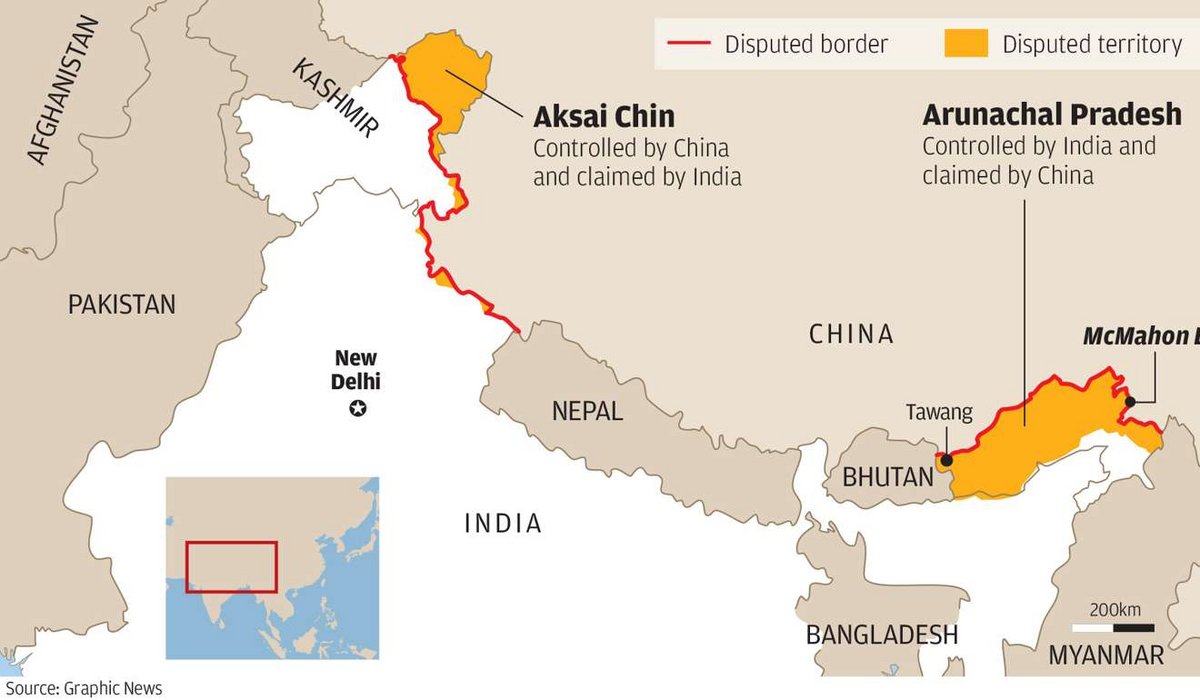Escalation between China and India
Peaceful co-existence or nuclear inferno at the Himalayas?
by Dr. Matin Baraki*, Marburg

(picture Bremerfriedensforum)
Unnoticed by the global public because of the corona pandemic, dangerous tensions are building up at the Himalayas. This is how the current situation between the two nuclear powers, the People’s republic of China and the Republic of India, can be summarised. Since the beginning of May China and India have concentrated additional troops along their common border. The Arena is located in 4000 meters of altitude in Ladakh, a high plateau, which India has claimed for a long time as a part of Kashmir. China has occupied the area East of Ladakh around Lake Aksayqin and renamed it to be Chinese territory.1 Not only here, but at many points in the Himalayas, the border is controversial, as the former colonial power Great Britain left the region in unclear circumstances. The factual border as it is tolerated by both sides is referred to as “Line of Actual Control” (LAC).2
India and China have kept accusing each other of provoking the other side by allegedly improper patrols and trespassing of the disputed border line. In 1962 this had culminated in a short but bloody war,3 which ended with the defeat of India. The disgraceful memory of this lost border conflict is still very much alive among the Indian elites.
On 5 May 2020 brawls between Chinese and Indian border patrols erupted, who engaged in fist fights on the shores of Lake Pangong. Tensions between both countries intensified on 25 May. In a severe brawl up to 250 soldiers were injured. It is the worst border crisis since 2017, when troops of the People’s Republic of China and India had a face-off in Doklam, close to the Kingdom of Bhutan. This confrontation had lasted for 73 days before it was stopped by negotiations between Chinese party leader and head of state Xi Jinping and Indian prime minister Narendra Modi.4
Again the situation looks highly explosive. India’s Prime Minister Narendra Modi gathered generals and his security Advisor Ajit Doval for a crisis meeting on 26 May, the talks revolved around “India’s military readiness”. The news Agency PTI emphasised: “China’s strategy to put military pressure on India will not work.”5 China’s head of state and ruling party Xi Jinping responded promptly. His country would increase the willingness to armed struggle, without, however, explicitly referring to the tensions in the Himalayas. Shortly before, a spokesman for the Chinese foreign Ministry had stressed that the country will maintain a “consistent and clear position” in the border conflict and that it is the duty of the Chinese army to defend China’s territories and national sovereignty. Now the tone gets rougher. The state-run “Global Times” published a report in which they spoke of several “illegal defenses” ranging into Chinese territory that have been built in India. The defence forces had no other option than to respond with movements of troops. India would bear the responsibility for the risk of an escalation.6
As early as mid of May Indian military analysts had raised the question of timing: Major General Ajay Das (retd.) spoke of the “aggressive maneuvers” of the Chinese military in the Himalayas as reminiscent of the behavior of the Chinese fleet in the South China sea. The newspaper “Financial Express” quoted the Indian security expert Ajey Lele with the words: “Why is this happening now, in the midst of the COVID-19-crisis?” Lele thinks that it is possible that China wanted to test the resolve of the Indian military, now that Delhi is so busy with the Coronavirus. And the former Indian Diplomat Phunchok Stobdan warns in the “Indian Express” against China intending to push back the Indian armed forces further West, in order to be closer to the strategically important Siachen glacier where Indian and Pakistani troops have been in a face-off for years.7 Since Pakistan and the People’s Republic of China are military and strategic partners such a move would increase the pressure on India.
Beijing, in turn, had practiced earlier criticism of the construction of an Indian street close to the lake and in response had tripled the number of their patrol boats on the lake. These projects – by 2020, at least 66 new roads along the border – are a response of India to China’s numerous infrastructure projects in the framework of its Initiative of the new silk road. Beijing has been expanding its influence in South Asia and Southeast Asia steadily in recent years, often venturing into regions which India has traditionally viewed as its exclusive backyard. In these remote areas India and the People’s Republic of China are separated by the 3,488 kilometres long LAC.8
It is in any case becoming increasingly clear: neither side seems to want to give in, no side wants to convey the impression that she breaks in the mountains since both the Chinese and the Indian government have fueled nationalist feelings for domestic political purposes in recent years. “India Today” reported on 27 May about the alleged transfer of 5,000 soldiers of the Chinese People’s Liberation Army to Ladakh. India would follow suit, if China was to increase the number of its troops, it was stated in press reports from New Delhi. The press agency Reuters quoted an Indian government spokesman as saying that defense systems would be built in the region on both sides of the border. Chinese trucks are to transport material into the region – an indication that Beijing could adjust to a longer conflict.9
Political commentators in India speak of an “unprecedented situation”. On 26 May the Beijing government announced to start evacuation of Chinese citizens beginning of June, including students, tourists and business travellers.
With the death of 20 Indian soldiers at the Indian-Chinese border in June a further escalation might have ocurred, strategists in the region warn. According to Indian sources there had been victims on the Chinese side, too. While the government in Beijing did not confirm this, the chief editor of the “Global Times” announced on twitter that there had been Chinese casualties.10 Brahma Chellaney, strategic expert at the Centre for Policy Research in Delhi, talked on Indian televion about a turning point. “After this incident things will never be the same again between India and China”11, he said. That sounded dire, since mutual distrust is already now quite profound. The foreign secretaries of both nuclear powers expressed their will to “cool down” the border conflict between the two countries. Both sides had a telephone conference. They agreed to handle the events in the Galwan valley „in a fair way“ and aim for a solution of the conflict.12
Noteworthy in conclusion, US administrations have tried for years to recruit India as a strategic partner and to instrumentalise the country against the PR of China.13 Already US president Bill Clinton had re-cognised India as the only nuclear power in South Asia rather than their closest long-time ally, the nuclear power Pakistan. The government in Beijing warns their counterparts in India not to let themselves be instrumentalised by the Trump administration in the China US controversy about the Republic of China (Taiwan) and Hongkong. One should hope that the political and military elites of India are self-confident and prudent enough not to let themselves be belittled to mere henchmen of the USA. •
1 cf. Baraki, Matin: “Kashmir – genesis of the conflict”, in: Current Concerns, No. 19, 9 September 2019.
2 cf. Fähnders, Till/Böge, Friederike: “Tote, aber keine Schüsse” (Deaths, but no gunfire), in: Frankfurter Allgemeine Zeitung (FAZ), 17 June 2020, p. 63
3 cf. ibid.
4 cf. Perras, Arne/Deuber, Lea: Grenzkonflikt im Himalaja: “Die Unruhe zwischen China und Indien wächst” (Border conflict in the Himalayas: The unrest between China and India is growing), in: Süddeutsche Zeitung (SZ), 27 May 2020.
5 ibid.
6 ibid.
7 ibid.
8 cf. Fähnders, Till/Böge, Friederike: “Tote, aber keine Schüsse”, in: FAZ, 17 June 2020, p. 6.
9 cf. Perras, Arne/Deuber, Lea: “Grenzkonflikt im Himalaja: Die Unruhe zwischen China und Indien wächst”, in: SZ, 27 May 2020.
10 cf. Fähnders, Till/Böge, Friederike: “Tote, aber keine Schüsse”, in: FAZ, 17.6.2020, p. 6.
11 Perras, Arne/Deuber, Lea: “Grenzkonflikt im Himalaja: Die Unruhe zwischen China und Indien wächst”, in: SZ, 27 May 2020.
12 cf. Fähnders, Till: “Entspannung im Himalaja” (Detente in the Himalayas), in: FAZ, 7 July 2020, p. 5.
13 cf. Fähnders, Till: “Gegen Chinas Salamitaktik” (Against China’s salami tactics), in: FAZ, 23 June 2020, p. 8.
